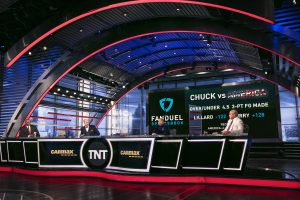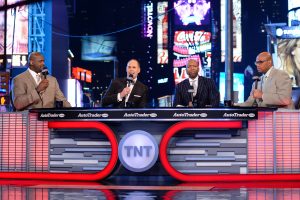SVG Sit-Down: Executive Producer Tim Kiely Provides an Inside Look at Inside the NBA
With a documentary set to air this week, Kiely reveals secrets of the legendary studio show
Story Highlights
This Thursday, TNT will air the first of a four-part documentary looking at the history of Inside the NBA, the groundbreaking studio show that has been informing and entertaining NBA fans for 30 years. Episodes air March 4-7, and Inside the NBA Executive Producer Tim Kiely sat down with SVG to discuss the evolution of the show, how it remains unique, and why the big board matters.

From left: Inside the NBA’s Shaquille O’Neal, Ernie Johnson, Kenny Smith, and Charles Barkley on set this year.
Has Inside the NBA always been in Studio J, or was it in a different location at the beginning?
I got there in 1996, and we would do the shows out of an old building called The Mansion that was originally with the property. It was hilarious as it was almost a little booth in a building where Ted [Turner] did CNN and also wrestling. We would see the wrestlers come in and out of the locker room as we were going into our studio. It was a pretty wild scene. Then Studio J came into existence when they built out the newer buildings. There were all kinds of state-of-the-art space, and there are about a half dozen studios the size of Studio J.
Walk us through the evolution of the set design and how it evolved to where it is today with the big board.
People tend to want to change the sets and do different things all the time. But, about 15 years ago, we fell onto this particular set, and it has just sort of evolved with the show itself. The big board, for example, was not meant to be a video breakdown thing. But we looked at it and said, Wait, could we do that?
It was experimentation. If the guys didn’t like something on the set, we would make fun of it because we make fun of everything. The spirit of the show is, we hope for mistakes to happen so we can celebrate them, things like Shaq [O’Neal] tripping over it and destroying things.
At one point, we had a sales stunt where Ernie [Johnson] drove a car into the set, and he actually clipped the set and busted off a chunk.
You mention that TV people like to change things. How do you not change things and fall into that trap of change for change’s sake?
The magic word is chemistry, whether it’s the people or whether it’s the technology. The technology is the same everywhere, so it’s a matter of how you use it and what your on-air people will buy into. Once we found things like the big board and the fact that the desk was very, very utilitarian, we could use it for a bunch of different things.
The big board works perfectly for Kenny [Smith] to be able to break down a play in a different way than what you see everywhere else. It’s almost like he directs the viewer a little bit, but he lets your eyes follow the action, as opposed to just putting it in your face, drawing lines and saying this guy’s gonna run here and this guy should run over there.
The original idea of the big board was not for things like highlights?
Yup, that was not it at all. It was just going to be a place for more graphics, lineups, and that sort of thing. But we started putting video into it for bumpers and then [VP/Coordinating Director] Steve Fiorello started to roll video into it, and Kenny loved it.
I do think that touchscreens are one of the worst inventions for on-air talent, [which] are trying to push buttons and also trying to think of what to say at the same time. You’ve lost the ability for creativity because they’ve totally lost their comfort. But, with the big board, Kenny is totally comfortable because it’s like the old coaching stuff, where they would hang a bedsheet and project the films on it. The guys can feel comfortable talking or using video or sound or whatever to their advantage.
Was there ever a thought of using green screen or virtual sets?
In the late ’90s, we were doing things like putting Ernie in green screen, and it just didn’t work out. It’s great for scripted things, but, once you start to have a conversation and you’re supposed to be referencing things around you, it doesn’t feel natural. And then it becomes mechanical. One of the first thing I tell people on set is to look at the person you’re talking to, listen to them, and then you’ll have a conversation. With green screen, you can be sitting in a vacuum.

Whether on the road, like here in 2014, or in Studio J, the Inside the NBA team always feels at home.
You mentioned not being afraid of making mistakes. Is that a challenge? To accept mistakes?
I think you embrace it. If we were doing a serious news show, that’s one thing, because you’re reporting on a murder and you’re on a scripted show where you need to hit a time and hard outs. Things evolved to where we started to look to the late-night talk shows, where [David] Letterman would do things like unabashedly make crew members part of the show. Our lighting guy became part of the show, and the viewer at home is fascinated to see how TV works. If a mic went out, we would tell the audio guy to go out on the set and fix the mic now. And the viewer at home doesn’t see anything wrong with that as they go to work and maybe read an insurance policy wrong.
And, if someone misspeaks, like Charles who is famous for contradicting himself in the same sentence, we would immediately roll it back. Twenty years ago, you couldn’t do that as someone would threaten to walk off the set. But players love busting each other’s chops, and the best thing in most busting of chops is when somebody makes a mistake.
What is the key to the chemistry that has developed?
When Kenny came on, he still wanted to play, and he thought this was a short-term thing. He didn’t pay any attention to the conventions of television, like looking at cameras. And he didn’t speak in soundbites: he talked and told stories.
I asked him once off camera, “Kenny, what was the moment when you figured out the NBA?” I thought he would tell me something about his rookie year in Sacramento, but he said it wasn’t until he got to Houston, which was five years later, and when he started to play in big games. He mentioned playing the Lakers and the Rockets’ scoring to go up by one and the clock was running out. He said he ran back to his defensive position, got in his stance, and Magic [Johnson] was walking the ball up real slow. The hair on my neck stood up, and I said, “Kenny, you’re telling that story on TV tonight.” And that’s what we hit, you know? We give you an idea of what it feels like to be in the NBA.
Charles famously said he was very close to signing with NBC, and then he watched [our coverage on] Turner and said, “They look like they’re having fun and, if this ain’t fun, I ain’t going to do it.” So he signed with us and then went nuclear on everything. It was so easy for him, and, on top of that, he was naturally funny and quick. Then Shaq just added the cherry on top: he comes in, and he’s just the biggest 11-year-old I’ve ever met in my life.
Talk about the relationship with the NBA and the development of Inside the NBA.
It was a hard sell at first because they had not seen anything like it before. When Charles first came on, we would go to halftime, and Ernie would say the score was 65-35, and then Chuck would say, “What a terrible game.” People went nuts and said, Don’t do that. But what saved us was Twitter. It became a new form of communication, and we needed to be on top of it and learn how to use it to our advantage.
People started tweeting that our guys were telling the truth, and everybody wanted to be part of Twitter and wanted the audience on Twitter because they were young. We had to accept the fact that, if we said it’s a great game, they would come back on Twitter and tell us we couldn’t be serious. That was the shift that allowed us to justify what we were doing.
I talked to Charles a couple weeks back, and he was talking about the fact that, if there are two bad games, it’s a really long night. Does Twitter help give the show more energy on nights like that?
Absolutely. In the beginning, we would use anything that was tweeted in, but now we’re a little bit pickier because people’s consciousness about Twitter has evolved. We’ll use a mean-spirited tweet if it makes them say something like Shaq doing his “your momma routine.” And Chuck’s the same way.
How did the documentary on Inside the NBA come about?
I’m somebody who works in today, and I don’t really think about yesterday or tomorrow. That’s just the way my head works. [Turner Sports EVP/CCO] Craig Barry deserves all the credit. He recognized that this would be a good thing to do because of the [30th] anniversary [in 2019]. I’ve seen one of the episodes, but I’m intentionally not watching the rest because I want to watch it in real time and, hopefully, enjoy it. I know I will, because I’ve seen the first episode and it was crazy. It captures the journey we took that was a lot of fun, and it’s still a ball, you know?
I can’t believe it sometimes. I mean, when we walk out at night, it’s 3:00 in the morning, and we’re out in the parking lot and people are laughing out loud. I was always very grateful for that and always felt like that was a blessing.
The documentary has a lot of great memories, some of which I’ve totally forgotten. It’s great to have it there, to thumb through it, and look back on it.
One last thing. The reason it’s called Studio J is, very early on, our head video engineer, Jim Reeves, passed away pretty suddenly. And Ernie decided to name it after Jim. That shows the kind of family feel we’ve always tried to bring with us.
